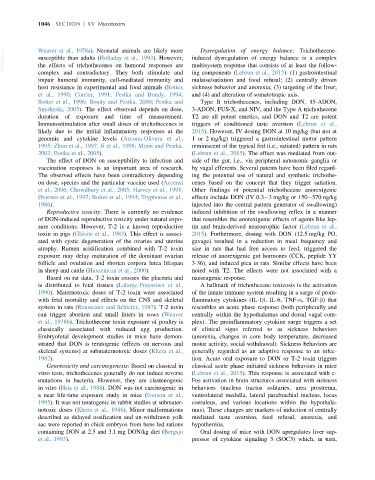Page 1114 - Veterinary Toxicology, Basic and Clinical Principles, 3rd Edition
P. 1114
1046 SECTION | XV Mycotoxins
VetBooks.ir Weaver et al., 1978a). Neonatal animals are likely more induced dysregulation of energy balance is a complex
Dysregulation of energy balance: Trichothecene-
susceptible than adults (Holladay et al., 1993). However,
multisystem response that consists of at least the follow-
the effects of trichothecenes on humoral responses are
complex and contradictory. They both stimulate and ing components (Lebrun et al., 2015): (1) gastrointestinal
impair humoral immunity, cell-mediated immunity and malaise/satiation and food refusal; (2) centrally driven
host resistance in experimental and food animals (Bottex sickness behavior and anorexia; (3) targeting of the liver;
et al., 1990; Corrier, 1991; Pestka and Bondy, 1994; and (4) and alteration of somatotropic axis.
Rotter et al., 1996; Bondy and Pestka, 2000; Pestka and Type B trichothecenes, including DON, 15-ADON,
Smolinski, 2005). The effect observed depends on dose, 3-ADON, FUS-X, and NIV, and the Type A trichothecene
duration of exposure and time of measurement. T2 are all potent emetics, and DON and T2 are potent
Immunostimulation after small doses of trichothecenes is triggers of conditioned taste aversion (Lebrun et al.,
likely due to the initial inflammatory responses at the 2015). However, IV dosing DON at 10 mg/kg (but not at
genomic and cytokine levels (Azcona-Olivera et al., 1 or 2 mg/kg) triggered a gastrointestinal motor pattern
1995; Zhou et al., 1997; Ji et al., 1998; Moon and Pestka, reminiscent of the typical fed (i.e., satiated) pattern in rats
2002; Pestka et al., 2005). (Lebrun et al., 2015). The effect was mediated from out-
The effect of DON on susceptibility to infection and side of the gut, i.e., via peripheral autonomic ganglia or
vaccination responses is an important area of research. by vagal efferents. Several patents have been filed regard-
The observed effects have been contradictory depending ing the potential use of natural and synthetic trichothe-
on dose, species and the particular vaccine used (Accensi cenes based on the concept that they trigger satiation.
et al., 2006; Chowdhury et al., 2005; Harvey et al., 1991; Other findings of potential trichothecene anorexigenic
Øvernes et al., 1997; Rotter et al., 1994; Tryphonas et al., effects include DON (IV 0.3 3 mg/kg or 150 570 ng/kg
1986). injected into the central pattern generator of swallowing)
Reproductive toxicity: There is currently no evidence induced inhibition of the swallowing reflex in a manner
of DON-induced reproductive toxicity under natural expo- that resembles the anorexigenic effects of agents like lep-
sure conditions. However, T-2 is a known reproductive tin and brain-derived neurotrophic factor (Lebrun et al.,
toxin in pigs (Gla ´vits et al., 1983). This effect is associ- 2015). Furthermore, dosing with DON (12.5 mg/kg PO,
ated with cystic degeneration of the ovaries and uterine gavage) resulted in a reduction in meal frequency and
atrophy. Rumen acidification combined with T-2 toxin size in rats that had free access to feed, triggered the
exposure may delay maturation of the dominant ovarian release of anorexigenic gut hormones (CCK, peptide YY
follicle and ovulation and shorten corpora lutea lifespan 3-36), and induced pica in rats. Similar effects have been
in sheep and cattle (Huszenicza et al., 2000). noted with T2. The effects were not associated with a
Based on rat data, T-2 toxin crosses the placenta and nauseagenic response.
is distributed to fetal tissues (Lafarge-Frayssinet et al., A hallmark of trichothecene toxicosis is the activation
1990). Maternotoxic doses of T-2 toxin were associated of the innate immune system resulting in a surge of proin-
with fetal mortality and effects on the CNS and skeletal flammatory cytokines (IL-1β, IL-6, TNF-α, TGF-β) that
system in rats (Rousseaux and Schiefer, 1987). T-2 toxin resembles an acute phase response (both peripherally and
can trigger abortion and small litters in sows (Weaver centrally within the hypothalamus and dorsal vagal com-
et al., 1978b). Trichothecene toxin exposure of poultry is plex). The proinflammatory cytokine surge triggers a set
classically associated with reduced egg production. of clinical signs referred to as sickness behaviors
Embryofetal development studies in mice have demon- (anorexia, changes in core body temperature, decreased
strated that DON is teratogenic (effects on nervous and motor activity, social withdrawal). Sickness behaviors are
skeletal systems) at submaternotoxic doses (Khera et al., generally regarded as an adaptive response to an infec-
1982). tion. Acute oral exposure to DON or T-2 toxin triggers
Genotoxicity and carcinogenesis: Based on classical in classical acute phase initiated sickness behaviors in mice
vitro tests, trichothecenes generally do not induce reverse (Lebrun et al., 2015). This response is associated with c-
mutations in bacteria. However, they are clastenogenic Fos activation in brain structures associated with sickness
in vitro (Hsia et al., 1988). DON was not carcinogenic in behaviors (nucleus tractus solitaries, area prostrema,
a near life-time exposure study in mice (Iverson et al., ventrolateral medulla, lateral parabrachial nucleus, locus
1995). It was not teratogenic in rabbit studies at submater- coeruleus, and various locations within the hypothala-
notoxic doses (Khera et al., 1986). Minor malformations mus). These changes are markers of induction of centrally
described as delayed ossification and un-withdrawn yolk mediated taste aversion, feed refusal, anorexia, and
sac were reported in chick embryos from hens fed rations hypothermia.
containing DON at 2.5 and 3.1 mg DON/kg diet (Bergsjo Oral dosing of mice with DON upregulates liver sup-
et al., 1993). pressor of cytokine signaling 3 (SOC3) which, in turn,

